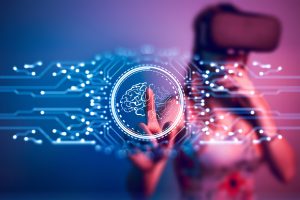
The Top 5 eLearning Trends for 2022
The eLearning market has grown exponentially over the last two years and will continue to grow at a rapid pace in the coming years, especially with the development of new technology and the changing face of work. According to eLearning statistics by Statista, the eLearning market is projected to grow globally, to over $240 billion by 2022.
As technology and trends are changing, the way employees learn is also changing. In this hyper-connected world, people are looking for eLearning techniques and tools that work best for their business. The way people learn and interact with information will continue to evolve. The future of eLearning will include more Virtual Reality, more Gamification, more Artificial Intelligence, and more 3D.
Looking ahead to the future is a really good way to learn more about your industry. It’s also good to plan so you can take advantage of any upcoming trends. If you are in the business of creating eLearning content or providing such services, then here are the top 5 eLearning trends you should consider for 2022.
 Mobile-first Learning
Mobile-first Learning
Leveraging technology to offer learners a platform on which they can access up-to-date professional development information is paramount in today’s competitive business environment. Mobile Learning is the trending approach for many businesses, higher educational organizations, and institutions as well. Technology has allowed the extension of training opportunities to their learners who may not have otherwise had the opportunity or access to professional development resources. The value of mobile Learning programs for organizations cannot be overstated as it presents an opportunity for enhancing lifelong learning for individuals serving in roles that regularly require them to update their knowledge and skillsets.
Mobile Learning has become cheaper and more popular by the day. Most businesses that have failed in developing a mobile-friendly strategy for learners haven’t realized how important it is to get one step ahead of their competition. The reason why it is used so widely is that over a billion people or half of the global population uses smartphones regularly to connect with family, find work, or study on the go. They no longer prefer textbooks or laptops! It’s now all about mobile platforms that help you learn right where you are wherever you are at any time of the day!
Gamification
 Learning need not be mundane and boring, especially when learning is online. Whether it’s training teachers in the field of education or doctors in the field of medicine, Gamification aims to make learning better for learners as well as the business and increase productivity at the same time.
Learning need not be mundane and boring, especially when learning is online. Whether it’s training teachers in the field of education or doctors in the field of medicine, Gamification aims to make learning better for learners as well as the business and increase productivity at the same time.
An effective learning strategy that uses game design thinking to foster intrinsic motivation, engagement, and collaboration, Gamification is the process of applying game-based mechanics, aesthetics, and rewards to nongame elements to make them more fun and engaging. By encouraging participation, companies can engage customers in a new way.
Gamification can be used to encourage desired behaviors, measure progress through behavior change, and increase motivation. It encourages the learner to advance to further stages by providing them with achievements, points, levels, or badges. It is used extensively not only in the eLearning field but also in online communities, marketing, and advertising.
Our last webinar on Gamification Strategies to Upskill & Reskill your Hybrid Workforce was testimony to the growing need and demand for Gamification, given the huge number of attendees.
Artificial Intelligence
Another trend fueling the learning revolution is the rise of Artificial Intelligence. Artificial intelligence is an electronic system that mimics human behavior which makes it a good fit for the eLearning industry. It makes it possible for users to take a personalized approach on their learning journey while receiving immediate feedback that makes it easier for them to adapt, improvise, and correct their course. Some organizations are using these brain-based technologies to not only train employees in immersive virtual environments but also to help reduce injuries, like in labor-intensive work environments, by 43%.
..with a touch of Immersive Instruction and Simulations
 In recent years, the use of Artificial Reality (AR), Virtual Reality (VR), and Mixed Reality (MR) in Gamification have gained traction with high engagement and retention rates. Augmented and Virtual Reality improvements in Edutainment or Gamification are paving the way for virtual classes. It earned $300 million in revenue in 2020, reports suggest. Simulations also enhance the Gamification tool by allowing learners to learn in an environment tailored to their preferences.
In recent years, the use of Artificial Reality (AR), Virtual Reality (VR), and Mixed Reality (MR) in Gamification have gained traction with high engagement and retention rates. Augmented and Virtual Reality improvements in Edutainment or Gamification are paving the way for virtual classes. It earned $300 million in revenue in 2020, reports suggest. Simulations also enhance the Gamification tool by allowing learners to learn in an environment tailored to their preferences.
These trends can be integrated into eLearning platforms to engage employees with their training programs.
Personalized Learning
Personalization is one of today’s most popular fads. People want their own unique experience, and personalized services are becoming more and more common for that reason. This includes aspects such as education in the form of eLearning or any other type of self-driven learning platform.
 The mass accumulation of data known as Big Data and its interpretation across many different vectors makes it possible to offer much more customized educational options to a wide array of individuals. It is up to the learning designer to find out as much as they can about their learners to help make these personal connections. This includes a learner’s behavior and history to better understand how they learn best.
The mass accumulation of data known as Big Data and its interpretation across many different vectors makes it possible to offer much more customized educational options to a wide array of individuals. It is up to the learning designer to find out as much as they can about their learners to help make these personal connections. This includes a learner’s behavior and history to better understand how they learn best.
Personalized training can come in all shapes and sizes. It could be something as simple as an onboarding course specifically geared toward your industry. Or it might be a complex Augmented Reality module for teaching employees the appropriate way to utilize machinery or technology at a more advanced level. No matter what personalized eLearning solution you choose, there are plenty of training modules to deliver through business models and goals.
Bite-sized Content
 With the increasing rate of information flow in today’s age, it is becoming increasingly difficult to maintain and pay attention to it all. The average attention span is shrinking for almost every type of subject. On average, an employee gets 24 minutes per week as the average amount of time dedicated to studying and learning career-related content. With such little time on hand and so much information to study every week, this new way of learning is introduced in the workplace to make the most out of it.
With the increasing rate of information flow in today’s age, it is becoming increasingly difficult to maintain and pay attention to it all. The average attention span is shrinking for almost every type of subject. On average, an employee gets 24 minutes per week as the average amount of time dedicated to studying and learning career-related content. With such little time on hand and so much information to study every week, this new way of learning is introduced in the workplace to make the most out of it.
Microlearning is a method of supplying learners with compact, condensed information for quicker knowledge consumption and enhanced retention. It makes efficient use of time, provides bite-sized explanations by using engaging media – all of this ultimately yields greater retention among employees which helps everyone individually and with overall business success at hand.
Microlearning platforms are progressively bringing to the table greater tools for students to effectively digest streamlined learning. While some use evaluation as their central mechanism, others utilize courses and Gamification to make the learning process fruitful. The focus has been on execution, which is benefiting organizations by giving them rich benefits.
What trends do you expect to see in the eLearning market in the coming year? Tell us in the comments.
If you are looking to stay on top of these trends and develop the best-in-class eLearning programs, write to us at moreinfo@aptaracorp.com.






No Comments